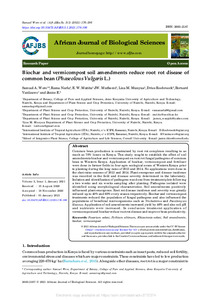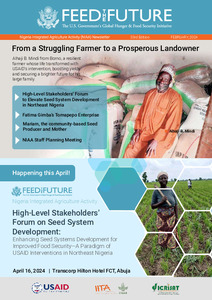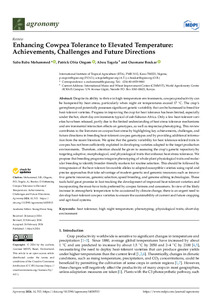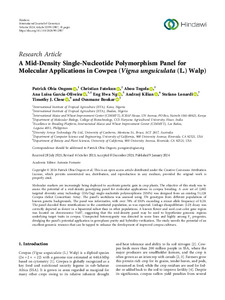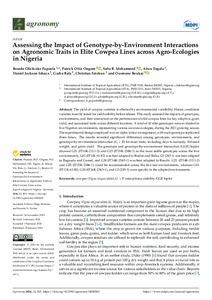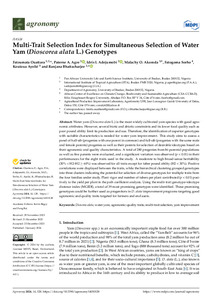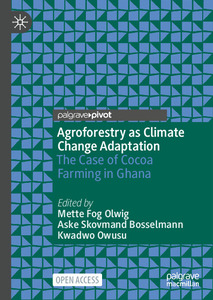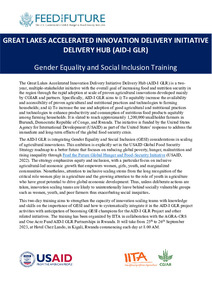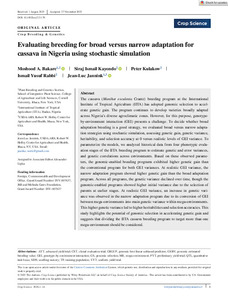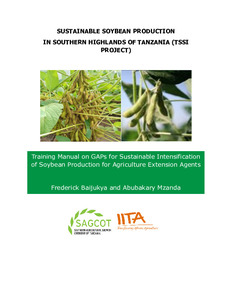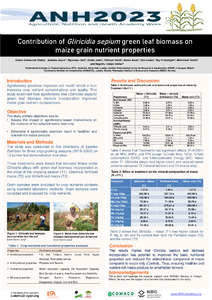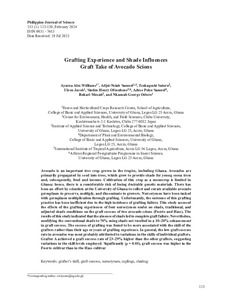Welcome to the International Institute of Tropical Agriculture Research Repository
IITA Bibliography System: Recent submissions
Now showing items 201-220 of 8094
-
Biochar and vermicompost soil amendments reduce root rot disease of common bean (Phaseolous Vulgaris L.)
(2021-01)Common bean production is constrained by root rot complexes resulting to as much as 70% losses in Kenya. This study sought to establish the effect of soil amendments biochar and vermicompost on root rot fungal pathogens of commonbean in Western Kenya. Application of biochar, vermicompost and fertilizer were done in farmer fields in four agro ecological zones of Western Kenya prior to planting during the long rains of 2013 and 2014. No applications were done in the shot rains seasons of 2013 and ... -
Feed the Future: Nigeria Integrated Agriculture Activity - 33rd Edition
(NIIA Newsletter, 2024-02) -
Enhancing cowpea tolerance to elevated temperature: achievements, challenges and future directions
(2024-03-01)Despite its ability to thrive in high-temperature environments, cowpea productivity can be hampered by heat stress, particularly when night air temperatures exceed 17 °C. The crop’s germplasm pool potentially possesses significant genetic variability that can be harnessed to breed for heat-tolerant varieties. Progress in improving the crop for heat tolerance has been limited, especially under the hot, short-day environments typical of sub-Saharan Africa. Only a few heat-tolerant varieties have ... -
A mid-density single-nucleotide polymorphism panel for molecular applications in cowpea (Vigna unguiculata (L.) Walp)
(2024-01-01)Molecular markers are increasingly being deployed to accelerate genetic gain in crop plants. The objective of this study was to assess the potential of a mid-density genotyping panel for molecular applications in cowpea breeding. A core set of 2,602 targeted diversity array technology (DArTag) single-nucleotide polymorphisms (SNPs) was designed from an existing 51,128 Cowpea iSelect Consortium Array. The panel’s usefulness was assessed using 376 genotypes from different populations of known genetic ... -
Social challenges and opportunities in agroforestry: cocoa farmers’ perspectives
(Palmgrave Macmillan, 2024)Agroforestry practices in cocoa cultivation have historical roots going back to the Mayan sacred groves in Mesoamerica. Today, agroforestry cocoa, i.e., the integration of shade trees, plants and crops in cocoa systems, is promoted as a climate smart practice by public and private institutions. Shaded cocoa can sustain or even increase cocoa yields and the agroforestry systems may provide additional output for household consumption and sale as well as improve the microclimate and soil conditions ... -
Assessing the impact of genotype-by-environment interactions on agronomic traits in elite cowpea lines across agro-ecologies in Nigeria
(2024)The yield of cowpea varieties is affected by environmental variability. Hence, candidate varieties must be tested for yield stability before release. This study assessed the impacts of genotypes, environments, and their interaction on the performance of elite cowpea lines for key adaptive, grain yield, and associated traits across different locations. A total of 42 elite genotypes were evaluated in five Nigerian environments, representing various savanna ecologies, during the 2021 growing season. ... -
Host plant resistance to insects in pulse crops
(Springer, 2024)Pulses are important sources of protein, dietary fiber, vitamins, and minerals for human nutrition and are widely cultivated in many countries around the world. Crops belonging to pulse include mainly chickpeas, mung bean, lentils, pigeon peas, and cowpeas. Pulse production and storage are negatively affected by a variety of biotic and abiotic factors, such as insect pests, diseases, parasites, low soil fertility, heat, and drought. Among these, insect pests have the most significant impact on ... -
Multi-trait selection index for simultaneous selection of water yam (Dioscorea alata L.) genotypes
(2024-01-03)Water yam (Dioscorea alata L.) is the most widely cultivated yam species with good agronomic attributes. However, several biotic and abiotic constraints and its lower food quality such as poor pound ability limit its production and use. Therefore, the identification of superior genotypes with suitable characteristics is needed for water yam improvement. This study aims to assess a panel of half-sib (progenies with one parent in common) and full-sib (progenies with the same male and female parents) ... -
Selection of extra-early white quality protein maize (Zea mays L.) inbred lines for drought and low soil nitrogen resilient hybrid production
(2024-01-30)In West and Central Africa (WCA), drought and low soil nitrogen (low N) impede increased maize (Zea mays L.) productivity and production. Due to climate change, the two stresses usually occur together, leading to food, nutritional, and economic insecurity in the sub-region. There is, therefore, the need for the development and availability of high-yielding extra-early maturing white Quality Protein Maize (QPM) synthetics and hybrids with resilience to the prevailing stresses through the identification ... -
Misattribution prevents learning
(2024)In many markets, consumers believe things about products that are not true. We study how incorrect beliefs about product quality can persist even after a consumer has used a product many times. We explore the example of fertilizer in East Africa. Farmers believe much local fertilizer is counterfeit or adulterated; however, multiple studies have established that nearly all fertilizer in the area is good quality. We develop a learning model to explain how these incorrect beliefs persist. We show ... -
Household economics of cocoa agroforestry: costs and benefits
(Palmgrave Macmillan, 2024)Current research suggests that cocoa agroforestry systems could offer stable yields, additional benefits and income from shade trees, despite potential added costs, such as from the purchase of insecticides. There is a paucity of profitability studies of different cocoa agroforestry systems. Only few of them go beyond a narrow focus on cocoa yields to model the entire agroforestry system and thus do not advance our understanding of the socio-economic value of other ecosystem goods. Based on survey ... -
Feed the Future: gender equality and social inclusion training
(United States Agency for International Development, 2023) -
Enhancing horticultural productivity, incomes and livelihoods through integrated management of aphid pests on vegetables in sub-Saharan Africa
(International Institute of Tropical Agriculture, 2016-09)Through several surveys and field trials we determined species composition and distribution of aphids as well as virus incidence on okra and cabbage in Cameroon and okra and kale in Kenya. On cabbage and kale, the cabbage aphid and false turnip aphid were, respectively, most important in higher and lower altitudes. The cabbage aphid in Kenya was associated with both specialist and generalist natural enemies whereas in Cameroon the specialist parasitoid Diaeretiella rapae was absent. Attempts to ... -
Fertilizer and soil health for enhanced productivity and sustainability in sub- Saharan Africa
(Scientific Panel on Responsible Plant Nutrition, 2024-02-06) -
A new multivariate agricultural drought composite index based on random forest algorithm and remote sensing data developed for Sahelian agrosystems
(2023-06-16)This manuscript aims to develop a new multivariate composite index for monitoring agricultural drought. To achieve this, the AVHRR, VIIRS, CHIRPS data series over a period of 40 years, rainfall and crop yield data as references were used. Variables include parameters for vegetative stress (SVCI, PV, SMN), water stress (PCI, RDI, NRDI), and heat stress (SMT, TCI, STCI), and a new variable related to environmental conditions was calculated through a normalized rainfall efficiency index. Then, random ... -
Soybean production manual: good agronomic practices for soybean production in northern Ghana
(SSPiNG Project, 2022-05) -
Evaluating breeding for broad versus narrow adaptation for cassava in Nigeria using stochastic simulation
(2024)The cassava (Manihot esculenta Crantz) breeding program at the International Institute of Tropical Agriculture (IITA) has adopted genomic selection to accelerate genetic gain. The program continues to develop varieties broadly adapted across Nigeria’s diverse agroclimatic zones. However, genotype by- environment interaction (GEI) presents a challenge for this purpose. To decide whether broad adaptation breeding is a good strategy, we evaluated broad versus narrow adaptation strategies using ... -
Sustainable soybean production in souther highlands of Tanzania (TSSI PROJECT): training manual on GAPs for sustainable intensification of soybean production for agriculture extension agents
(IInternational Institute of Tropical Agriculture, 2023) -
Contribution of Gliricidia sepium green leaf biomass on maize grain nutrient properties
(International Institute of Tropical Agriculture, 2023) -
Grafting experience and shade influences graft take of avocado scions
(2024-02)Avocado is an important tree crop grown in the tropics, including Ghana. Avocados are primarily propagated by seed into trees, which grow to provide shade for young cocoa trees and, subsequently, food and income. Cultivation of this crop as a monocrop is limited in Ghana; hence, there is a considerable risk of losing desirable genetic materials. There has been an effort by scientists at the University of Ghana to collect and curate available avocado germplasm to preserve, multiply, and disseminate ...

